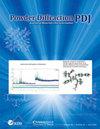多孔柱状氰基镍酸镍(3-氨基-4,4′-联吡啶)[Ni(CN)4]的晶体结构和同步辐射 X 射线粉末参考图谱
IF 0.4
4区 材料科学
Q4 MATERIALS SCIENCE, CHARACTERIZATION & TESTING
引用次数: 0
摘要
利用同步辐射 X 射线衍射法测定了粉末状 Ni(3-氨基-4,4′-联吡啶)[Ni(CN)4](或称为 Ni-BpyNH2)的结构,并利用里特维尔德精炼技术(R = 8.8%)对其进行了精炼。Ni-BpyNH2 形成了一个三维网络,二维 Ni(CN)4 网通过 BpyNH2 配体相互连接。网络上有两个独立的 Ni 位点。二维网络通过吡啶 "N "原子与 Ni2 的结合相互连接。Ni2 位点与 N 具有六倍配位,与四倍配位的 Ni1-C 间距(平均 1.850 Å)相比,Ni2-N 间距相对较长(平均 2.118 Å)。Ni(CN)4 网呈波浪状排列。官能团 -NH2 是无序的,相对于吡啶环的 N 原子处于 m 位置。在四个 m 位中,N 原子不是处于唯一的位置,而是各占 1/4 个位点。Ni-BpyNH2 的粉末参考衍射图样已经制作完成,并提交给了国际衍射数据中心(ICDD)的粉末衍射文件(PDF)。本文章由计算机程序翻译,如有差异,请以英文原文为准。
Crystal structure and synchrotron X-ray powder reference pattern for the porous pillared cyanonickelate, Ni(3-amino-4,4′-bipyridine)[Ni(CN)4]
The structure of Ni(3-amino-4,4′-bipyridine)[Ni(CN)4 ] (or known as Ni-BpyNH2 ) in powder form was determined using synchrotron X-ray diffraction and refined using the Rietveld refinement technique (R = 8.8%). The orthorhombic (Cmca ) cell parameters were determined to be a = 14.7218(3) Å, b = 22.6615(3) Å, c = 12.3833(3) Å, V = 4131.29(9) Å3 , and Z = 8. Ni-BpyNH2 forms a 3-D network, with a 2-D Ni(CN)4 net connecting to each other via the BpyNH2 ligands. There are two independent Ni sites on the net. The 2-D nets are connected to each other via the bonding of the pyridine “N” atom to Ni2. The Ni2 site is of six-fold coordination to N with relatively long Ni2–N distances (average of 2.118 Å) as compared to the four-fold coordinated Ni1–C distances (average of 1.850 Å). The Ni(CN)4 net is arranged in a wave-like fashion. The functional group, –NH2 , is disordered and was found to be in the m -position relative to the N atom of the pyridine ring. Instead of having a unique position, N has ¼ site occupancy in each of the four m -positions. The powder reference diffraction pattern for Ni-BpyNH2 was prepared and submitted to the Powder Diffraction File (PDF) at the International Centre of Diffraction Data (ICDD).
求助全文
通过发布文献求助,成功后即可免费获取论文全文。
去求助
来源期刊

Powder Diffraction
工程技术-材料科学:表征与测试
CiteScore
0.90
自引率
0.00%
发文量
50
审稿时长
>12 weeks
期刊介绍:
Powder Diffraction is a quarterly journal publishing articles, both experimental and theoretical, on the use of powder diffraction and related techniques for the characterization of crystalline materials. It is published by Cambridge University Press (CUP) for the International Centre for Diffraction Data (ICDD).
 求助内容:
求助内容: 应助结果提醒方式:
应助结果提醒方式:


